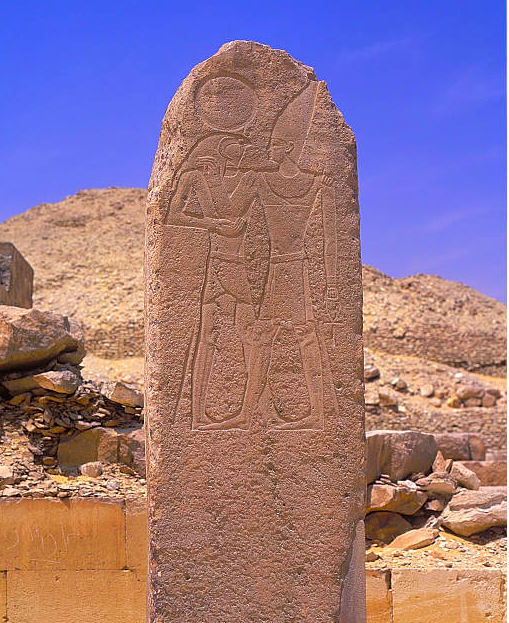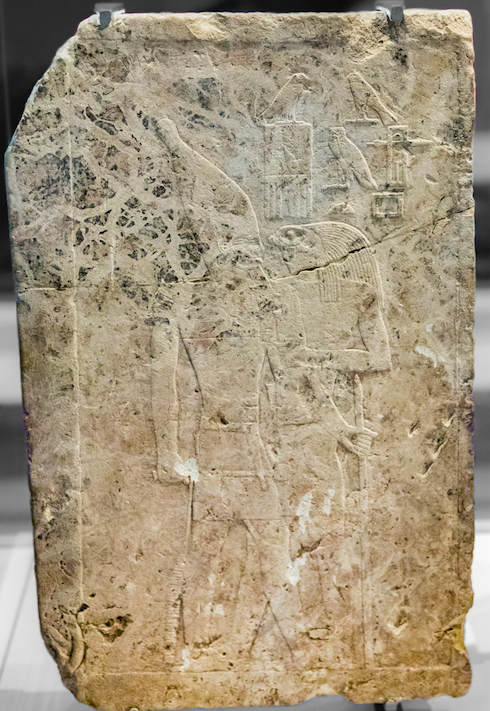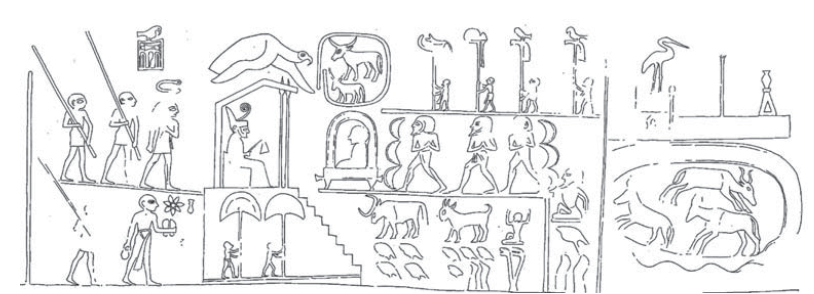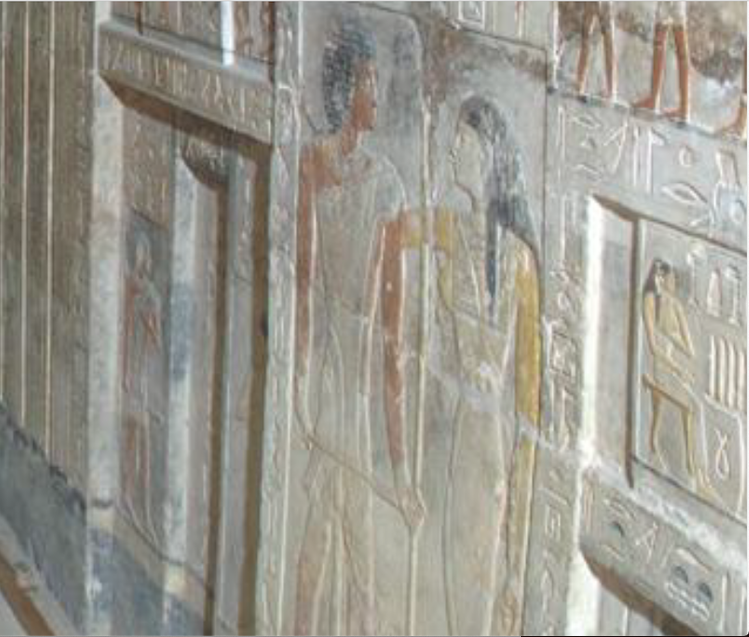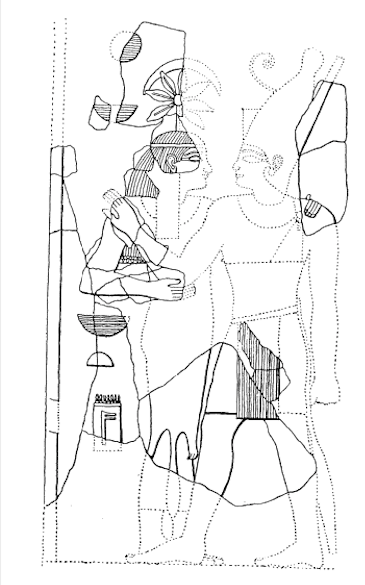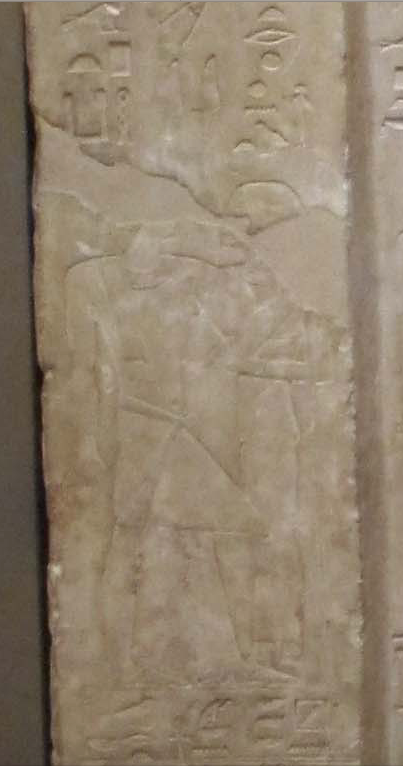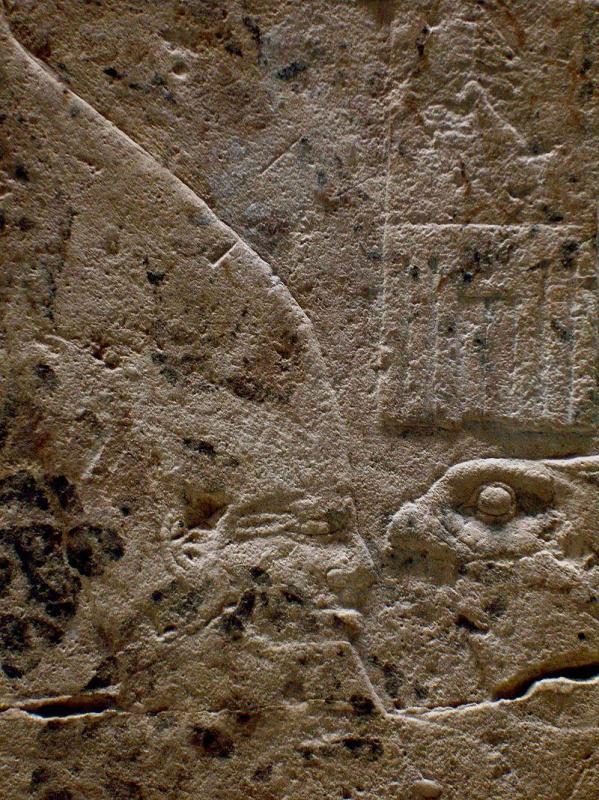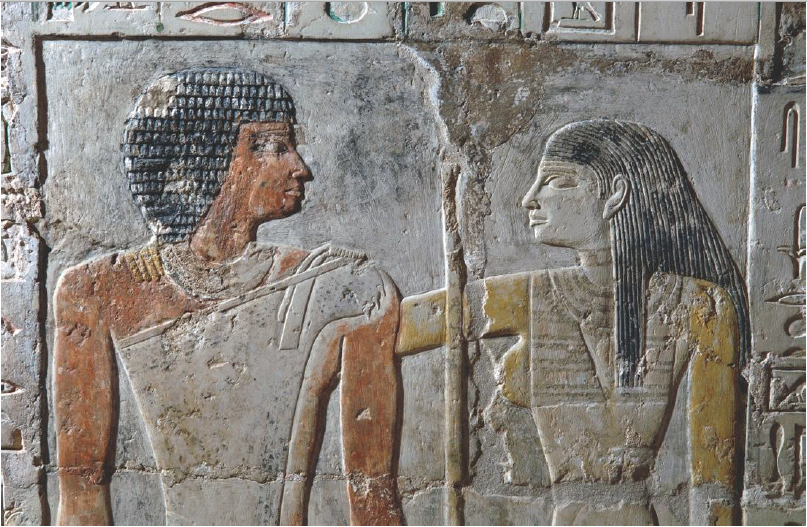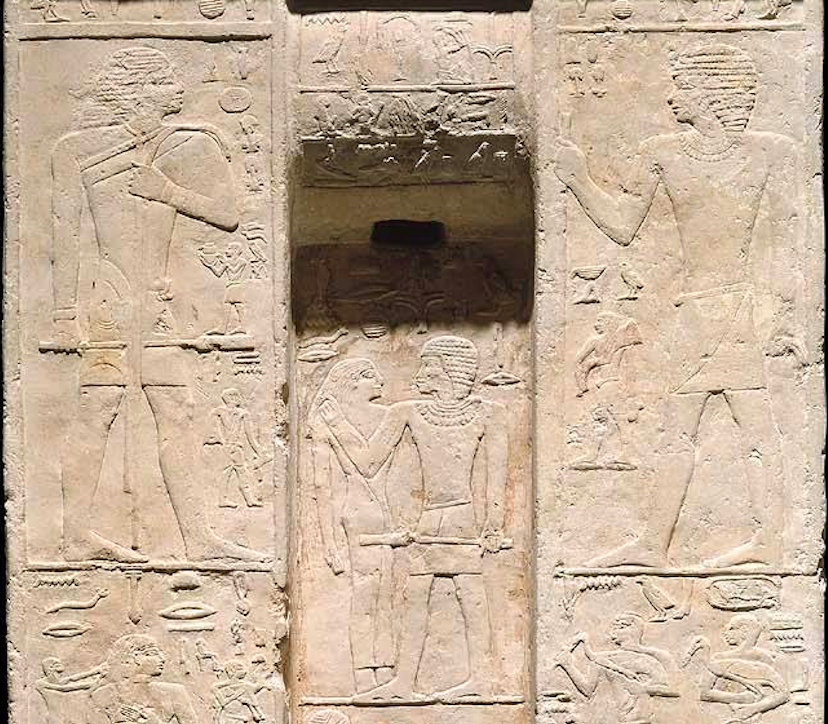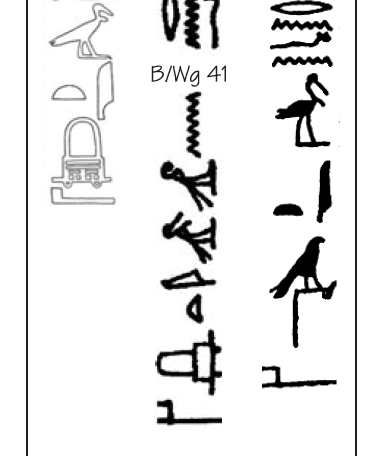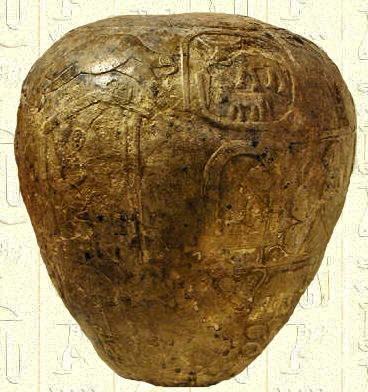The Two ‘bas’
The two ‘bas ’
Stele preserved in the Louvre (E 25982, fig. 1), of the pharaoh "Qa-hedjet, the one who is high above (by the) white crown (= Upper Egypt)" who is believed to be a pharaoh of the 3rd dynasty.
The date of the stele is subject to discussion, but we prefer the one mentioned above. In addition to the style generally recognised as belonging to the Third Dynasty, the entire content of the scene sculpted in bas-relief required such a knowledge of early Egyptian religion that a forger or even a learned Egyptian of a later period could not have imagined this scene, which is unique in certain aspects.
Moreover, the panel, with its rough outline (height 50 cm, width 31 cm and thickness 2.80 cm), but with a very refined bas-relief, was originally intended to be embedded in a wall, according to a technique specific to the Third Dynasty, used in the step pyramid of Pharaoh Djeser.
fig. 1: Panel of the pharaoh Qahedjet. Louvre E 25982. © Alain Guilleux - photos Égypte.
Fig. 2: Detail of the stele of Qahedjet.
© Wikipedia commons https://en.wikipedia.org/wiki/Qahedjet
Photo : © Juan Rodrigez Lazaro sur Flikr.
1) Description of the scene.
Horus with the head of a hawk, called "Horus in the house 'great castle'" (on the right), places his right arm on the Pharaoh's shoulder, and his left arm on the Pharaoh's elbow, in the same way as a wife embraces her husband:
- fig. 3 : Wife's arm at the shoulder, spouses Kahai and Meret-ites, Vth dynasty, Saqqara),
- fig. 4 : Wife's arm at the shoulder and elbow of the husband, false door of Sameri, Vth dynasty (Bologna, KS 1901).
- fig. 5 : Wife's arm at the shoulder, false door of Sen-ouhem, VIth Dynasty, Boston Museum of Fine Art no. 27.444.
The reverse (a husband placing his arm on the wife's shoulder and his other arm on the wife's elbow) is never attested.
Fig. 3 : The notable Kahai, standing holding a staff and a kherep sceptre, is embraced by his wife Merit-ites. Photos taken from M. Westerlund's article, "Kahai and Nefer's tomb", Manchester, 2014, pp. 4 and 9, figs. 1 and 4. These photos are taken from https://www.livescience.com/41237-love-revealed-in-egypt-tomb.html, accessed 23/07/2020.
Fig. 4 : False door of Sameri, left jamb (Vth dynasty, Bologna museum). Closer embrace of the husband by his wife Khenout, who holds her husband's right shoulder in one hand and his left elbow in the other hand. The groom holds a stick and a cloth.(http://www.museibologna.it/archeologicoen/percorsi/66288/id/74873/oggetto/74863/)
Fig. 5 : False door stele of Sen-Ouhem, VIth Dynasty, Giza (tomb G 2132) © Harvard University Boston Museum of Fine Art Expedition, no. 27.444. The wife embraces her husband, her right hand on his left shoulder holding a kherep sceptre.
On the stele of Qahedjet, the scene representing a gesture belonging to the spouses, therefore fundamentally signifies a marriage.
Furthermore, the pharaoh Horus Qahedjet, whose falcon is represented on the castle of 'the one who is high in the white crown', adopts, according to the Texts of the Pyramids, the attitude of Osiris N who, according to the Texts of the Pyramids, is "taken, šd" (PT 485), "protected, n?" (e.g. PT 371, 636, 649) by Horus with a falcon's head "in the house 'great castle'".
The expression "Horus who protects (n?) his father (Osiris)" is frequent in the Texts of the Pyramids (PT 364, 367, 371, 422, 589, 593, 606, 611, 720).
Now such protection (n?) was also the role of the wife adopting the same embracing gesture as Horus himself.
This is why we read in the Texts of the Pyramids that Horus not only protected his father, but also the eye (jr.t fem. = wife) of Horus 'protects (n?)' osiris N, (cf. PT 101, 260 protection mkt, 468 the eye/red crown), the goddesses Isis and Nephthys (PT 357, 593 z?w), the great Ennead (= wife) (PT 593).
Similarly, in the royal bas-reliefs from Dynasty IV onwards, the goddess Seshat was depicted embracing the pharaoh Snefru, exactly like a wife (Fig. 6):
Fig. 6 : The goddess Séchat embraces Snéfrou. (Fakhry, 1961, fig. 84 ; Schneider, 1997, fig. 5.1).
Pharaoh Pepi II preferred to be embraced in the same way by a god, Ra-Harakhty (Harakhty =Horus of the two horizons). The latter with his wife called "the two horizons", is then seen as a wife of the pharaoh (fig. 7):
Fig. 7: Pillar of the courtyard of the high temple of Pepi II. Emphasis on the eye shadow line, recalling the stele of Qahedjet. Photo © Frank P. Roy on his site: The Pyramids of Egypt,
http://egyptphoto.ncf.ca/pyramid%20of%20pepi%20II%20temple%20court2.htm
This pharaoh Horus N (Pepy II or Qahedjet), through his marital union with Horus with the head of a hawk, 'filled himself' (PT 637 infra) with what belonged to the latter Horus, i.e. 'the two horizons (Akhty)', the 'house 'great castle' (?wt-??t)', the 'eye (=wife) of Horus', so that Osiris N himself became Horus.
In fact, according to the formula of the Texts of the Pyramids PT 303 (cited below), Osiris N is identified with two Horus, Horus "son (=heir) of Osiris", and Horus "son (=heir) of Hathor (Hathor means the castle of Horus)", so that Osiris N becomes the "second (snnw)", i.e. the equal of Horus:
PT 303 (W/A/N 6) :
"§467 You are Horus son of Osiris (?wt ?r z? Wsjr); You are N (?wt N) (=character on the left)
the eldest god, the son (=heir) of Hathor (Hathor means "Castle of Horus") (n?r smsw, s? ?wt-?r) (=character on the right)
and you are the seed of Geb (?wt mtwt Gb)
(say the gods).
For Osiris commanded that (Osiris) N should appear as the second of Horus (jw w?~n Wsjr ?? N m snnw ?r);
and those four spirits akh which are in On a document of the two great gods in the firmament (jw zš~n fdw jpw ??w jmyw Jwnw jr ? n n?rwy ??w m qb?w ); "
Conversely, Osiris N, identified with Horus, was also called "?s?s jt=f, the equal of his father" after having taken as his wife, "the inheritance of his father, the thrones of Geb, his members, those who are in the Nou, Maat, his eye" (PT 260).
Thus Osiris N, having become Horus, could say that he "protected himself" from those who would take food, breath or life from him (PT 254), "from all those who would speak against him" (PT 665B). For N is stronger than his enemies, "having appeared on his bank (=wife)" (PT 254).
2) The club of King Narmer (first name to be read henceforth Abu Hor, the desire of Horus) also includes a scene depicting the marriage of the two Horus/bas.
On the stele of the pharaoh Horus Qa-hedjet, this denarius carries in his right hand a Hedj club, symbol of royal power and which means "to be white, luminous" and "to destroy (the enemies)" (cf. scene of the destruction of the enemies with a club on the stele of King Narmer).
However, the same Hedj club, that of King Narmer (/Abu-Hor "?b(w) ?r, the wished of Horus"), a pharaoh who reigned at the end of Dynasty 0 or founder of Dynasty 1, bears a particular scene (drawing below fig. 4).
Fig. 4:
Club head of King Narmer (read Abu-Hor, the desire of Horus) ;
drawing by Mary Winkes, after N. B. Millet
, JARCE 28,1991, fig. 1, p. 224.
Ashmolean Museum N° inv. AN 1896-1908 E 3631
Fig. 5: Mace of King Narmer (Abu Hor), from Hierakonpolis (ancient Nekhen), main depot; photo public domain ;
site : The Narmer Catalog (https://www.narmer.org/inscription/0080# )
This hedj club has a scene in bas-relief, which represents the meeting of two characters:
1) on the left: the pharaoh Horus Narmer/Abou-Hor, on the castle/serekh, "son of Osiris" (PT 303) (see below), sitting under a kiosk.
2) on the right, Horus in a totally human form this time, in a sedan chair (=castle).
This is Horus "son of Hathor (=' Castle of Horus')" (PT 303), as indicated by the image above the sedan chair: a calf and its mother the cow Hesat or Hathor (cf. PT 303) in an enclosure (=the "house ' big castle '" (according to the Qahedjet stele), the sedan chair.
This sedan chair is indeed that of Horus-wife, because, according to formula 423 of the Pyramid Texts (cited below), Horus who unites with his father is called "Horus of the sedan chair" with the hieroglyphic (determinative) sign of the sedan chair, whose design is identical to that of the club (cf. fig. 6).
PT 423 (P/F/Wg 31 N/F/Wg 37 Nt/F/W 59): "Horus is a ba (b? jr=f ?r) (=right) and he recognises (=uniting) his father in you (left), in his name 'Horus of the sedan chair (the determinative is the design of a sedan chair with a domed roof, identical to the one on the club, cf. fig. 6) ' ba of the sovereign ' (jp=f jt=f jm=k m rn=f n ?r b? jt(y));
Fig. 6 : "Horus of the sedan chair 'ba of the sovereign'"., cf. TP 423 cf. J. P. Allen, A new concordance of Pyramid Texts, 2019 :
http://ancientworldonline.blogspot.com/2013/07/a-new-concordance-of-pyramid-texts.html
This Horus/calf has the role of the wife, as he stands at the head of the offerings of the people he represents. The wife was considered as a divine offering for her husband (infra and PT 173, formula quoted infra, comprising two homonyms, the verb 'to unite j?b', action of Horus and the name of the grain offering ?b.t, allowing us to assimilate Horus with the offering).
Furthermore, as on the stele of Qahedjet, Horus is represented as a hybrid being, a man with the head of an animal (in this case a falcon), likewise, on the club of Narmer/Abou-Hor, Horus is represented in two forms, human (in the sedan chair) and animal (the calf).
The whole scene is indeed a wedding, as this scene is explained by two other representations on the right (cf. drawing below) on the club, with only symbols in this sense :
1) The jabiru bird symbolising "the ba"/Osiris N, overhanging a chapel, and recalling Horus on the castle, on the stele of Horus Q?-?? supra.
This ba is placed in front of a jar/offering (= wife) recalling "Horus in the castle"/jar, and Horus/calf/offering.
Moreover, the jar is situated to the right of the jabiru ba, exactly like Horus/calf/offering to the right of the pharaoh Horus N, and like Horus in the castle on the stele of Qahedjet.
2) And the crenellated circle surrounding gazelles designates the city called "Gehesty, that of the gazelle", the place where Horus found Osiris on his side (gs), i.e., dead (PT 485; 637, formulae cited below).
The enclosure represents the womb of Isis, which surrounds the deified men/gods/gazelles/Horus 'in the castle' (=wife). The goddess is described as both mother and wife of Horus (PT 518, infra).
This image describes the result of the union of the two Horus/two bottoms, i.e. the union/marriage of Horus with the goddess mother and wife (=the gods) (cf. infra).
The enclosure, wall, or rampart was also assimilated to the wife in the formulas PT 255 and 509, "the ramparts (znb.t, wife) of Chou" (cf. infra).
Now, all the scenes of the club were described in formulas in the Texts of the Pyramids as a union between the two Horus:
- Horus is also called "Ra, the golden calf son of the cow Hesat" (TP 485).
- This Horus having 'found Osiris N dead at Gehesty' (TP 637), 'takes the arm' (union) of Osiris N (TP 485) for heaven (=wife). - Or "Horus of the sedan chair 'ba of the sovereign' (determining a sedan chair similar to that of the club, cf. photo infra fig.6)" is also a ba (TP 423) like Osiris/Horus N/jabiru on his chapel (cf. the club).
- Horus unites (j?b) with Osiris N (TP 173) who fills himself (m?) with Horus, and thus becomes Horus himself (TP 637).
PT 485 (P/A/W 53 M/A/S 1)
"This N (Pharaoh Osiris N) has come to you, Ra (=Horus), jw~n N pn ?r=k R?
the golden calf, which heaven gave birth to, b?z n nwb, msw pt
the undeveloped (Faulkner: bold) golden calf, which ?s?t has created ( ??? n nwb, qm?w ?z?t.
Horus, take this N with you alive and stable,
Horus, don't abandon him (n sjw N pn).(...)
Geb (in the same role as Horus, infra) came (...) looking for Osiris (m z?nw Wsjr), and he found him placed on his side in G?sty (the city of the gazelle) (gm~n=f sw dy ?r gs=f m g?st)
Horus, take him with you to heaven, take him with you to heaven (?r šd sw ?n?=k jr pt)
Horus on the cushion of the bulwark of the sky (?r ?r šdšd pt), give your arm to this N (dj r=k ?=k n N) so that this N can go out to heaven (=wife) (prj N pn jr pt). »
PT 173 (T/F/E ii 15 N/F/Ne B v 3 Nt/F/Ne B iv 1)
"O O Osiris N, Horus has come that he may join you, for you are his father. Grain offering ?bt (jw~n ?r j?b=f kw ?wt jt=f, ?bt) "
PT 637 (Na/F/Ne B iv 87 Nb/F/E 50) §1799
"Horus comes filled with ointment. He is looking for his father Osiris (z?n~n=f jt=f), and he finds him on his side in G?sty (gm~n=f sw ?r gs=f m G?sty). Osiris was filled with the eye of the one he gave birth to (Horus)".
This scene from the club of Narmer/Abou-Hor, showing Horus/calf as a wife-offering, thus depicts a marriage between two Horus, one depicted as a pharaoh (called Horus on the serekh) in a pavilion and the other depicted humanely in the sedan chair and animal as a calf in an enclosure, thus recalling the hybrid Horus "in the house 'the great castle'" of the Qahedjet stele.
3) The "stable" conjugal union of Osiris-Horus with heaven/gods (=wife)
This marriage of the two Horus had as its purpose another union. Or this marriage was itself also the sign of this other union described in a different way, that of Osiris/Horus N with the sky (wife, cf. TP 485 supra), the eye (wife) of Horus/Ra/calf.
In fact, the "interlacing z?n" (=marital union) of the two Horus/two bottoms on the stele of Qahedjet, allowed Osiris/Horus N to become a Horus "stable at the head of the sky (wife)", as this formula indicates:
PT 667A (P/F/Se B, N/F/Se B, Nta/F/Sw Ntb/F/E)
§1944 O king, you did not die of death (n mwt~n=k js mt=tj)
You are alive being alive among them (=wife), (?n?~n=k ?n?=tj m-?b=sn)
spirits that do not know destruction (imperishable) (=wife).
come, flood (jy, ??t),
provided the moods out of Osiris, (jw?g r?w pr m Wsjr)
that Horus can be cleansed of what his brother Seth did against him, (w?b ?r m-? jrt~n sn=f Stš jr=f)
and that Seth can be cleansed (w?b) of what his brother Horus did against him (w?b Stš m-? jrt~n sn=f ?r jr=f)
that this N can be cleansed of all evil against it,
that the watchmen (wršw) can be purified (=united conjugally) for Horus, w?b wršw n ?r
after he hugged (embraced) his father Osiris.(z?n~n=f jt=f Wsjr)
that he appeared (??~n=f) on the lake (=wife), on his throne ?nd (=wife), (?r š ?r ?ndw)
after he sliced the iron/firmament (=wife) (dm~n=e bj?)
by means of his spirit akh (m ??=e)
(...)
Oho! Don't get up, like Min, ?z ?w, mjn js,
may you fly to heaven (=wife) (jp?=k jr pt)
because you live with them (=wife), (?n?t=k ?n?=sn)
you will enlarge your two (according to the TP of N, Nt) wings (jsrd=k ?n?=k),
with your plumage on your head, šwt=k m tp=k,
and your plumage on both your arms ( šwt=k tp q??y=k ),
Illuminate (zbš n=k) the sky for you ,
shining for them like a god, (jps?t jr=sn, n?r js)
stable at the head of the sky (=wife)
tel Horus (mntj ?ntj pt ?r js)".
The "stability, mn" was thus linked to the conjugal state of Osiris N/Horus with the gods / heaven (wife), also called :
- the "crown wrrt",
- its iron limbs (?wt bj?)", the "sky (p.t)",
- the "field of reeds (= male gods) (s?t j??w)",
- the "field of offerings s?t ?tp (=female gods)",
- the "imperishable stars",
- the "Osiris suit" (TP 419, formula quoted below).
PT 419 (T/SP (=A-S)/S 12 M/A/Eg 25) :
"N is a large, healthy crown wrrt (=wife) (N pw wr, w?? wrrt)
N provides for himself with his iron limbs (wife) (?tp sw N m ?wt bj?t)
Cross the sky (N will cross the sky (=wife)) for the field of reeds (male gods, wife) (nhp N pt jr s?t j??w)
N will make her stability (abode) in the field of offerings (goddesses=wife) among the imperishable stars (wife), the following of Osiris (jr jmn=f m s?t ?tp mm j?m-sk, sšmw Wsjr)".
Osiris N becomes the "stable bull (jmnw) of the bulls (sm?.w) (the gods, wife)" (TP 474, 480, cited below), because Horus "made stable the arm of Osiris over life (=wife) and power (=wife)" (TP 477), for prosperity and health (=wife, cf. The Royal Throne II).
PT 474 (Pa/A/W 22 Pb/APn/W An/F/E 153 M//A/Wg 30 N/A/W 8 Nt/F/Nw 18) :
"I bring for you the stockings of Pe (=wife) (jn=j n=k b?w P),
I have gathered for you the stockings of Nekhen (wife) (dm?(=j) n=k b?w N?n)
and all that is yours (n=k tm), says Geb,
who spoke with Atoum about what he did (mdw ?r=s ?n? tm) (jrt~n=f pw).
The fields of reeds, the mounds of Horus, the mounds of Set (wife), everything is yours (n=k tm) says Geb.
who spoke with Atoum about what he has done for you.
He (Set) has come against you
and he said (?d~n=e) that he will kill you (sm?=e ?w),
but he won't kill you,
You will kill him (?wt sm?=k sw),
you will make yourself stable against him (smn=k ?w jr=f) ,
as the most stable bull sm?w (m jmnw n sm?w);
recite (djed pillar) four times, be stable in life and power w?s, you will be stable, being stable in life and power w?s .
PT 477 (P/A/W 27 M/A/W 29 N/A/W 15) :
"N came to you, master, N came to you Osiris,
he'll clean your face,
that he dress you in the garment of the god,
let him do for you what Geb ordered him to do for you:
he makes your arm stable on life (wife), N (smn=f ?=k ?r ?n?)
he raises (carries) your arm under (= carrying) the sceptre w?s (wife) (f?y N ?=k ?r w?s)".
PT 480 (T/A/N 17 P/A/W 40 An/B/E ii 15 N/A/W 50)
"N Atoum's father grabs N's arm (n?r~n=f jt n N Tm ? n N)
he places N at the head of these gods (wife) (wd=f N m ?nty n?rw pf)
who are excellent, wise and do not perish (sbqw, ss??, jw jtmw sk)
See, what was said to you gods, that N would not be at your head (m?n nw ?d n=?n n?rw, tm N wnn m ?ntj=?n)
see, N is stable to your head
as the stable bull jmnw of the wild bulls (wife) (A: as the most established of the wild bulls) (m?n N mn m ?ntj=?n m jmnw n sm?w)".
Osiris N "made stable" the gods by his "descent"/marriage with "those who are on the road to prosperity of the heart (=the gods, wife)" (PT 518 formula quoted below).
PT 518 (P/Cn/W 16 M/Cm/E 23 N/Cm/E 22)
"N found the gods standing (gm~n N n?rw ???w),
wrapped in their clothing (=wife) (knmw m mn?.wt=sn),
their white sandals (=wife) at their feet (?bwt=sn ??t r rd.wy=sn).
They threw their white sandals (former wife) on the ground s?~jn=sn ?b.wt=sn ??t jr t?,
and got rid of their clothes (former wife)(sz?~jn=sn mn?wt=sn)
We are not happy (litt. sound of heart) until your descent (=marriage)'' they say (n w?? jb=n jr h?t=k, jn=sn)
No sooner had you spoken, than the pavement/dromos (=wife, = Isis cf. infra) were made stable for you (?d~n=?n, jsmn~n=?n s?m)
Prosperity of the heart' (=wife) is the name of this causeway/dromos to the north of the field of offering (s?m w??-jb, rn n s?m pw m?t s?t ?tp (det. bread lying horizontally).
Rise up, Osiris, and command N for those who are on the causeway 'prosperity of the heart' (=wife) north of the field of offering (??? jr=k Wsjr, w?=k n n ?rw s?m s?m w??-jb m?tj s?t ?tp ),
as you commanded Horus to Isis (=mother and wife, compared to the causeway 'prosperity of the heart') on that day when you made her pregnant (mj w?=k ?r n ?st hrw sjwr~n=k s jm)".
And this 'descent' was a marital union. Indeed, according to this last formula PT 518, when the god Osiris 'ordered, w?' N to the gods (wife) who are on the road to heart-prosperity, he did it exactly as 'he ordered Horus (husband) to Isis (wife), when he made her pregnant (TP 518 cited infra);
Now the mother (=people) was also the wife of the son, as several PT formulas indicate (cf. the pages The mother and the maiden, The mother, the milk) and the epithet of Horus "bull (=husband) of his mother" (from the Middle Kingdom onwards).
Thus it was the god himself who "ordered, w?" or sealed the marriage himself, as many other texts prove (e.g. stele of the first marriage of Ramses II to a Hittite princess), and as we will prove further by describing the wedding ceremony.
4) The marriage of the two 'bas' in the Middle and New Kingdoms, and the feast of 'we are stable'.
The "two bas", Osiris and Ra, according to formula 335 of the Texts of the Sarcophagi (=CT) and 17 of the Book of the Dead (=BD), "one embracing (?pt, CT 335 (CT IV 278d) and BD 17 (E.A.W. Budge, The Book of the Dead, The papyrus of Ani, London, 1895, p. 42) the other", were also called
- yesterday and tomorrow",
- " Harendotes (Horus who protects his father) "
- and "Horus Mekhenty-en-irty (face/front of both eyes (= the castle) (or) who does not have both eyes)".
These two Horus are reminiscent of those on the stele of Qa-hedjet.
This hugging and embracing corresponded to a coronation ritual called "we are stable":
CT 335 : " Going out in the daylight. (...) who is Atoum? It is Atoum who is in his record. Yesterday belongs to me, and I know the next day. - Yesterday it's Osiris (1), and the next day it's Atoum (var. Ra);
(1) : the sarc. BH1 Br adds in front of this gloss : " who is it ? it is the day of We are stable/We are to die ; it is when Osiris was buried and his son Horus was enthroned sovereign (hrw pf? n jw=n mn=n, qrs.t Wsjr pw ?n? s?q? s?=f ?r)
(...)
I am the one whose Two Stockings reside in his Two Chicks,
- What is it? The one whose two bas reside in his two chicks is Osiris at his entry into Mendes (Busiris = wife).
There he found the ba of Ra standing opposite, and then one of them kissed (?pt) the other; hence The One with the Two bas.
As for his two chicks, they are Harendotes (i.e. Horus who protects his father) and Horus-Mekhenty-en-irty".
LdM 17: "Yesterday belongs to me and I know tomorrow. Who is it? - Yesterday it is Osiris, tomorrow it is Re, on that day when the enemies of the master of the universe are annihilated and his son Horus is made to reign (?n? s?q?=tw s?=e ?r). Another version : it is the day of the feast 'We are stable/We remain', it is when the tomb/burial of Osiris was arranged by his father Re (hrw pwy n jw=n mn ?b, dhn~n=tw qrs pw Wsjr, jn jt=e R?).
(...)
I am the one whose two stockings reside in his two chicks.
Who are they? Osiris, on entering Mendes, found the ba of Ra; so one kissed (?pt) the other. Thus in result the one with the two stockings.
The two chicks are Harendotes and Horus-Mekhenty-irty.
Another version: The one whose two bas reside in the two chicks is the ba of Ra, it is the ba of Osiris, it is the ba of the one in whom is Cabbage, it is the ba of the one in whom is Tefnut; it is the one in whose two bas are those of Mendes (=the gods, wife)".
The interlacing (?tp) of Horus/Ra with Osiris, allowed Osiris to be Horus at the head of the sky (PT 667A supra), at the head of his two eyes (Mekhenty-en-irty), and thus to be cleansed of what Set did against him (PT 667A).
Hence the very stressed importance of the face-to-face vision between the two Horus on the stele of Qahedjet. For Osiris N it is a question of taking the eyes (=the gods, wife) of Horus to see, according to many formulas in the Texts of the Pyramids.
Conclusion on the two 'bas' and the perpetual uniqueness of marriage
In short, the conjugal union of the two Horus/two bottoms, allowed the formation of a single Horus/"the one with the two bottoms", conjugally united to "heaven", to the "gods", to "those who are in Mendes", the divinised men (wife of Horus).
This conjugal union of the two bottoms was represented in two ways:
1)Either Osiris/Horus N (serekh) is united to Horus with the head of a falcon "in the castle",
2)or the same Osiris/Horus N (serekh) is united to the castle of Horus (=?wt-Hr = Hathor) or other goddess.
In both cases, it is the same marriage because the goddess/castle formed the "limbs" (PT 260, 419 supra) even of Horus with a hawk's head "in the castle".
This vital alliance between Osiris/Horus N (serekh) and Horus "in the castle (=the gods, wife)", replaced an old one:
That of the gods (wife) whose "white sandals (?bwt ??t), clothes (mn?wt)", were "thrown (sti)", "got rid (sz?)" (PT 518 quoted above) by the gods themselves, because they did not have a prosperous heart, until N descended (union) onto the roadway henceforth called by N "prosperity of the heart".
In other words, the sandals and clothes symbolised the unprosperous heart of the gods (wife), because they were united with a bad husband, a god who was not N.
The gesture of throwing them to the ground, signified a breaking of the covenant with this god-husband.
Like the sandals and the garments, the pavement 'prosperity of heart' symbolised, as its name suggests, the heart of the gods, but this time the heart of the gods prospers, and thus the gods themselves form a new covenant as wife (remarried), with N (himself remarried after death, as Osiris/Horus) (PT 518 P/Cn/W 16 M/Cm/E 23 N/Cm/E 22).
N was indeed the husband of the gods (wife), because, according to the rest of the formula, N is ordained (w?) in marriage by Osiris, to those on the causeway (= the gods), exactly "as Osiris ordained Horus (husband) to Isis (mother and wife, causeway = the gods) when he made her pregnant".
Thus the prosperity of the heart meant the joy of the wife (gods) with her husband (Osiris/Horus N serekh).
This prosperity of the heart, all spousal, was symbolised by the white sandals, the clothes, the pavement of the gods-wife of N.
For these ornaments and this place, could also mean the sad heart of the gods because of a bad husband, a god other than Osiris/Horus (serekh) (cf. infra, this god could be Chou or Ra).
Other formulas illustrate a break-up of a wife (the gods) with a god other than N, so that she can remarry N :
In formula PT 509 (P/Cm/E 71 N/A/S B 3), N as a bull "overthrows the ramparts (=wife) of Chou (husband) (sšn znbt šw)", "§1125a so that he stands in his empty place (jm st šwt) (=wife) which is between the two great gods".
In (PT 255), Chou is described as "the detestable of construction (=alliance) (?b? qd), the detestable of form (=alliance) (?b? jrw)". And he is asked to "chase you out of your place (=wife) (jdr ?w ?r st=k), put your badge (your dignity, wife) down for this N (w??=k s??=k r t? n N pn)".
If this is not done, N "will strike the arms of Cabbage carrying Nut (=wife), and N will place his shoulder (as a bull) in this rampart (=wife) on which you (=Cabbage) rest (your shoulder) (wd k? N pn rmn=f m znbt tw rmnt=k r=s)".
The empty place (wife) could also be that of Ra (husband), whom N chases away, to take his place, according to the formula 267 (W/A/S) :
"§366b he (=N) flies as a bird (jp?=f m ?pd),
he poses as a beetle (?nn=f m ?pr),
on the empty throne in your boat, O Ra (m nst šwt jmyt wj?=k, R?)".
Then it is ordered to Ra this:
"§367a stand up, withdraw (litt. hunt) (???, jdr ?w),
you who no longer know a reed thicket (= the gods, wife), j?m jwt
that this N can sit (=unite) on your seat (?ms W pn m st=k),
and row (union) in the sky, in your boat, Ra! ( ?nny=f m pt m wj?=k R?) ".
Thus Ra is summoned to separate himself from the wife (empty throne, reed-filled, boat) that he no longer knows, i.e. with whom he is disengaged, so that N can sit on it (= marital union, remarriage), row in it.
Other formulas illustrate differently the necessity of breaking with the wife in order for her to remarry: In formula 476, a scribe (sš) is ordered to "crush (s?)" his "palette (mn??)", to "break (?bs)" his "brush (?r)", to "unroll, hnn" his "scrolls (m??wt)".
These objects at the scribe's disposal are metaphors for the wife. Indeed, "the scroll of the god" (TP 250), means that the scroll belongs to the god, just as the wife belonged to her husband. In fact, when N is called "the scribe of the book of the god" (TP 510), the belonging of the "book" to the scribe N and to the god, recalls the link of the wife (book) to her husband N identified with the god who has the same wife.
These objects, palette, brushes, scrolls, represent the wife well, because according to the rest of formula 476, the scribe, by separating his material, immediately loses his place/throne (st), another symbol of the wife. In fact, Ra is charged with "driving (dr)" this scribe out of his place and putting N in his place (=the old bride who has become the new bride) so that N is white (b?q) (=divine), having the wife/place and carrying the staff ?bt (=wife).
We can see that a wife had to be "destroyed", removed from her former husband, in order for N to marry the former wife (remarriage for her but also remarriage of N since N was Osiris, former husband, dead and became Horus (new husband) on the serekh (temple, wife).
Conversely, it was the gods (wife) who could be bad: It is said elsewhere that the father of N (=N) had to "make his heart (= N's alliance with the gods (wife))", "another (heart) having been taken away for him, (ky šdy n=f)", because this heart, "was opposed, ??k" to N's father "going out to heaven (= immortality), so that he waded in these winding streams (rhn=f m nnwt n??). "(TP 512 P/Cm/W 55 N/Cm/W 66).
This heart was a covenant of N with evil gods (wife), because they left N on the ground. On the contrary, N's alliance with the gods Anubis and Geb, allowed N, at the same time to "keep the earth and rule the spirits akhu", to be purified and divinised, stable, to "cross the sky", to be "among the gods gone for their kaou", to appropriate the akh, luminous spirit, according to the end of the formula ("go in your spirit akh").
Thus to contract a new alliance/marriage, it was necessary to break with the old one, either by death or divorce. Hence the perpetual uniqueness of marriage, i.e. the impossibility for a husband to have several simultaneous wives (polygamy), and the imperative for both spouses of successive marriages, after divorce or death of one of the spouses.
This fundamental aspect of matrimonial law was particularly well expressed from the New Kingdom onwards, in a letter (practice text) and a legal text :
- in a letter (P. BM 10416) dating from the New Empire and coming from Deir el-Medineh. The "mistress" of a married man is strongly advised to take the latter to court with his wife in title, so that he may take the oath of divorce and marry his "mistress":
"(vs. l. 8-10) If the heart of this (married) man is for you (=the mistress) (jnn jb n p?y rm? r=t), let him go to court with his wife (jm ?q=f r t? qnbt jrm t?y=f ?mt), take the (divorce) oath and come to your house (=remarriage), mtw=f ?rq=f, <10> mtw=f jy r p?y=t »[1].
- in a law on alimony contracts, and more specifically, on the inheritance of children from two successive wives (after divorce) of their father. This law was cited in P BM 10591 (family archives of Siout, including a trial from the Ptolemaic period), and was called the "law of the year 21". It was probably promulgated under Amasis (XXVIth dynasty).
Indeed, in P. BM 10591, the pharaoh is not named, but he can only be a pharaoh (the lagid king of the time did not reign for as long); this pharaoh can only be Amasis, the last legislator according to Herodotus. In fact, it is under his reign that the food contracts mentioned in this law appeared.[2].
Here is the content:
"If a man marries (litt. sits with) a woman (j-jr rm? ?ms jrm s-?mt),
and he writes a feed contract for her,
and he has a son from her, and he divorces her (litt. he throws her away, mtw=f ?wy.?=s),
and he marries (litt. sits with) another woman (mtw=f ?ms jrm gr s.?mt),
and he writes a feed contract for her (mtw=f s? n=s s?n?),
and he has a son from her (nty-jw šr ?pr n=f jrm=s),
when man dies (nty-jw p? rm? n rn=f mwt), his property (n?y=f nkt.w),
they are given to the children of the previous wife for whom he has written a feeding contract before (j-jr ?r tw=w st n n? ?r?.w (n) t? ?mt r-sš=f n=s r s?n? n ??t)
»[3].
This perpetual uniqueness of marriage was also affirmed by a fact attested as early as the Old Kingdom but also during the 3000 years of the institution of the ancient Egyptian marriage:
It was the god who "ordered (w?)" or sealed conjugal love, that is to say that he divinized this love by making it "like that of Horus with his mother Isis" (PT 518), or like that of Horus/Osiris N/pharaoh/ba/the two bottoms, with his people (divinized men=Isis, the sky).
Since the wife of Horus is compared to his (=d'Horus') mother (unique and divine), Isis (PT 518), it follows that the marriage was thus perpetually unique.
Furthermore, the fact that the god ordered the spouses to each other and sealed their love in a unique and perpetual way, it also follows that the uniqueness of the marriage was a divine seal.
All these religious texts using the terms of the common law marriage, allow us to affirm that the latter symbolised that of Horus with his people (=Isis), at the time of the coronation, on the feast of "we are stable/we shall remain".
(PT 419, 477,480, 518 et CT 335, BD 17).
Transposition of the embracing ritual (?tp) of Osiris N by Horus (Qahedjet stele, CT 335, BD 17), in the Songs of Love.
This divine marriage represented on the stele of Qahedjet, by the embrace (?pt) of the pharaoh Horus N, arms open, by the falcon-headed god Horus, was transposed in the Songs of Love (New Kingdom), as evidenced by the use of the verb "?pt, embrace" (CT 335 and BD 17), and a discreet reminder of the coronation ritual:
(Cairo Vase, O. DM 1266, stanza 6, 15 :
"(He = the brother identified with the god) When I (= the sister = Osiris N) 'embrace him, his arms open towards me (?pt=j s.w gb.wy=s pš=w ?r=j) ,
as if I was the one who came from pount (=the god Amon) (mj nty m Pwn.t),
it's like a misy plant turned into a mixture, whose perfume resembles that of ladanum (jw=f mj mjsy pr=y m dm?.t, [...jw] sty=s n? jbr.w) ".
The brother (=the god Amun of Pount) embraces (?pt) the sister (=Osiris N and the gods forming the own body of Osiris) and this embrace (=marital union) has the perfume of Pount, i.e., a mixture (dm?.t), which resembles ladanum, a perfume attested in the ritual of confirmation of royal power (cf. J.-Cl Goyon, Confirmation of royal power, BdE LII, 1972, p. 95 and n. 103).
The sister represents Osiris N and the gods (=wife, body of Osiris), because she welcomes the brother exactly as the gods welcomed the god Amun of Pount and his perfume:
Great Hymn to Amon of Cairo (P. Boulaq 17, 2,4 = A. Mariette, P. Boulaq II, 1872, pl. 11) :
"The gods love his (=Amon) perfume when he comes back from Punt ( mrr n?r.w sty=f ?ft jy=f m Pwnt)".
Laure de Lamotte ©
[1] (J. J. Janssen, « Marriage Problems and Public Relations (P. BM 10416) », dans J. Baines, T. G. H. James, A. Leahy, A. F. Shores (éd.), Pyramid Studies and Other Essays Presented to I.E.S. Edwards, 1988, p. 134-137, pl. 25-28 ; J. J. Janssen, Late Ramesside Letters and communications (HPBM VI), 1991, p. 28-32, pl. 15-18 ; E. Wente, Letters from Ancient Egypt, 1990, p. 203 ; F. Neuveu, « Problèmes familiaux et solutions juridiques : divorce et adoption à l’époque ramesside » Egypte 20, 2001, p. 25-31 ; J. Gee, « Notes on Egyptian Marriage : P. BM 10416 Reconsidered », BES 15, 2001, p. 17-21).
[2] J.J. Johnson « ‘Annutity Contracts’ and Marriage », SAOC 55, 1994, p. 113; S. Allam, « Réflexion sur le “code légal” d'Hermopolis dans l'Égypte ancienne » CdE 61, 1986, p. 73, n. 1.)
[3] P. BM 10591 (IIe siècle av. J.-C), rto X, 7-9) (H. Thompson, A Family Archive from Siut, Oxford, 1934, B. x:7-9 ; cité par P. W. Pestman, Marriage and matrimonial property in ancient Egypt, P.L. Bat. 9, 1961, p. 44.
Horus son of Osiris and Horus son of Hathor
The pharao Qa-hedjet (« The one whose white crown (= Upper Egypt) is high ») of the third dynasty (bas-relief kep in Louvre).
Horus with falcon head, who embrace, like always does the spouse, and who is called « Horus in the big castle » (to the right), represents humanity conjugally united with the souvereign Horus on the castle of ‘ the one whose white crown is high ’ » (to the left).
The two were forming just one, according to this formula of Pyramids' Texts, adressed to the dead king :
TP 303 (W/A/N 6), §467 :
« You are Horus son of Osiris (?wt ?r z? Wsjr); You are N (?wt N) (=personnage to the left)
the eldest god, the son of Hathor («Horus' castle ») ( n?r smsw, s? ?wt-?r) (=personnage to the right)
et you are the seed of Geb (?wt mtwt Gb) (=the two personnages)
(say the gods).
Because Osiris commended that N appear as the second of Horus (jw w?~n Wsjr ?? N m snnw ?r);
et those four spirits akh who are in On, writed (this) on the document of the two great gods (=Osiris et Horus) in the firmament (jw zš~n fdw jpw ??w jmyw Jwnw jr ? n n?rwy ??w m qb?w );
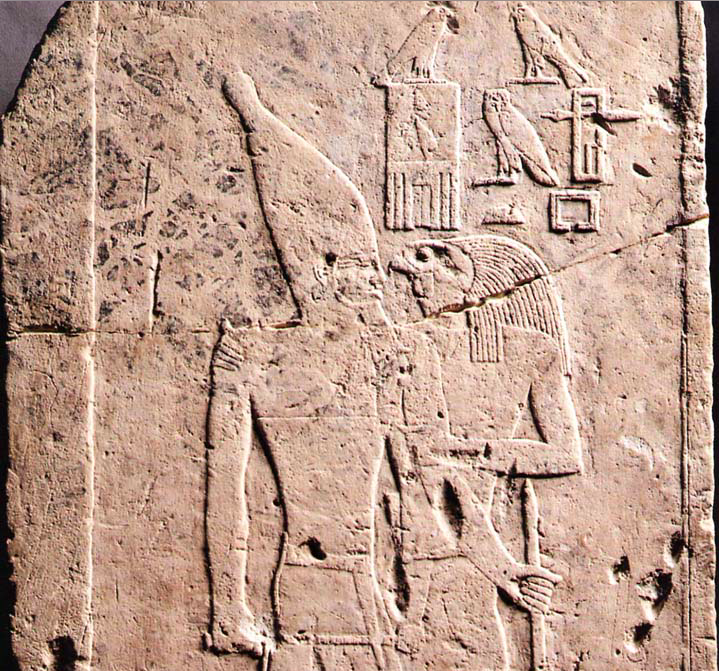
The pharaoh Horus son of Osiris is wearing a mace Hedj wich signify « to be white, bright » and « smash (foes) », capacities obtained by the conjugal union of the two gods.
Indeed, on the mace Hedj of the king Narmer, (name to be read henceforth « ?b ?r, the desired one of Horus » (end of dynasty 0 ou founder of the first dynasty ; Ashmolean museum d'Oxford), one finds represented the marriage of those two gods, « Horus who is in the great castle » playing the wife's role.
Indeed, this mace represents the conjugal union between :
1) to the right : the pharao Horus son of Osiris. We can see also the bird jabiru ba représented further to the right, and the town of the gazelle (the circle with the gazelles symbolise the inhabitants), « Gehesty », place were Horus founded Osiris dead (infra)),
2) to the left, Horus, the calf, son of the cow Hesat ou Hathor (cf. TP 303 infra), who presents himself at the head of the offerings/of his people that he represents. He has the fonction of the spouse (cf. forthcoming paper).
It is the réunion of the two bas, of the double ba.
cf. TP 485 (P/A/W 53 M/A/S 1)
« This N (= pharaoh) has come to you, Rê (=Horus),
(Rê/Horus) the calf of god, which the sky has given birth,
the calf undevelopped (Faulkner : fat) of gold, that ?s?t has created (jw~n N pn ?r=k R?, b?z n nwb, msw pt, ??? n nwb, qm?w ?z?t.
Horus, take for you the N with you, living and stable, Horus, don't leave him (n sjw N pn).(...)
Geb (same function as Horus, infra) has come (...) looking for Osiris (m z?nw Wsjr), and he found him put on his side in G?sty (the town of the gazelle) (gm~n=f sw dy ?r gs=f m g?st)
Horus, take him with you to the sky, take him with you to the sky (?r šd sw ?n?=k jr pt)
Horus on the cushion of the bulwark of the sky (?r ?r šdšd pt), give your arm to this N (dj r=k ?=k n N) that this N might go out to the sky (prj N pn jr pt). »
TP 423 (P/F/Wg 31 N/F/Wg 37 Nt/F/W 59): « Horus is a ba (b? jr=f ?r) (=to the left) et il recognise his father in you (to the right), in this his name ‘ Horus of the sedan chair (the déterminative is the picture of a sedan chair, with domed roof, identical with the one on the mace) ‘ ba of the sovereign ’ » (jp=f jt=f jm=k m rn=f n ?r b? jt(y)) »;
TP 173 (T/F/E ii 15 N/F/Ne B v 3 Nt/F/Ne B iv 1)
« O Osiris N, Horus has come that he might join himself to you, because you are his father. Offering of grain ?bt (jw~n ?r j?b=f kw ?wt jt=f, ?bt) »
TP 637 (Na/F/Ne B iv 87 Nb/F/E 50) §1799 « Horus comes filled with ointments. He looks for his father Osiris (z?n~n=f jt=f), and he finds him on his side in Gehesty (gm~n=f sw ?r gs=f m G?sty). Osiris has filled himself with the eye of the one he has given birth (=Horus) ».
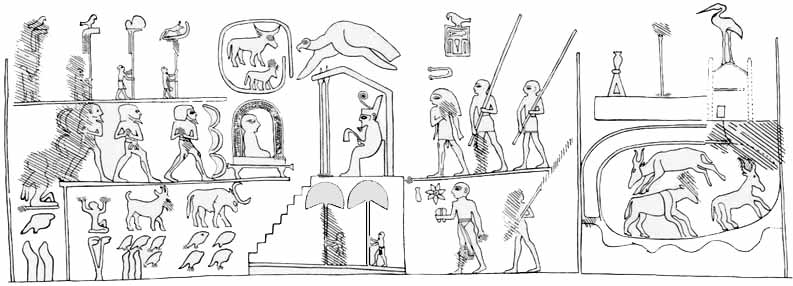
The formula of Pyramids Texts cited supra (TP 423), décribes the ritual représented sur la massue: indeed, the déterminative of the sedan chair identical to the one on the mace :
TP 423 (P/F/Wg 31 N/F/Wg 37 Nt/F/W 59): « Horus is a ba (b? jr=f ?r) (=to the left) and he recognize his father in you (to the right), in this his name of ‘ Horus of the sedan chair ‘ ba of the sovereign ’ » (jp=f jt=f jm=k m rn=f n ?r b? jt(y)) »
Laure de Lamotte ©
Last edited: 03/06/2021
Add a comment



